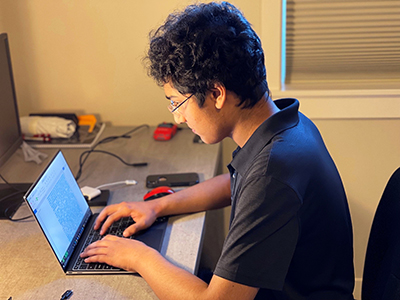Empowerment Through Assistive Technologies

“For most of us, technology makes things easier. For a person with a disability, it makes things possible.” by Judy Heumann, American Disability Rights Activist and Former US Assistant Secretary
While in high school, I often wondered about the challenges I would face in college; some tasks that come naturally for others, are sometimes harder for me. For example, I can struggle with taking notes while trying to follow along. I sometimes have trouble focusing on the teacher in class while also capturing notes, and this ends up affecting my understanding of the concepts being discussed.
DO-IT introduced me to assistive technologies such as Sonocent Audio Notetaker, Inspiration graphic organizer software, and Moleskine Smart Pen, which opened me up to a world of opportunities. Sonocent is a note-taking software that allows students to understand lectures and discussions more effectively. I have used the Sonocent audio notetaker during my lectures at DO-IT and was able to focus on the important parts of the lecture while the software captured audio notes for me to review later. Inspiration helped me to be more organized and accomplish a specific task by using concept maps, mind maps, diagrams, graphic organizers, outlines, and presentations. I learned that the Moleskine Smart Pen allows me to amplify my handwritten ideas using digital technology. It helps me transfer words, graphics, ideas, and events directly to my smartphone, tablet or PC. These three assistive technologies can really help me overcome some of the key challenges that inhibit my learning.
My experience at DO-IT also made me curious about other assistive technology gadgets and software that are available. Some research on the internet made me aware of a number of excellent gadgets and tools and the ones that stood out for me are the AV1 Robot, MathTalk, Liftware, and Talkitt. The AV1 Robot acts as the student’s voice and ears if they miss school due to a long absence, and makes it possible to receive education being taught in class from home through an app on a tablet or smartphone. The AV1 also enables the child to stay socially connected with friends, and also take part in different school activities on their own time. Since I like mathematics, I found MathTalk to be an interesting piece of assistive technology. MathTalk allows the user to voice all types of math from algebra, pre-algebra, calculus, trigonometry, graphs, and statistics. The software enables physically challenged professionals, teachers, and students to voice out math without having to use a keyboard. The user can print out math work, and learn to speak distinctly and clearly. Another piece of technology that intrigued me was Liftware. Liftware helps people with motor disabilities to stabilize and reduce spilling of contents while eating. Liftware acts as a self-stabilizing handle that’s attached to the eating utensil—like a spoon or fork—thereby reducing shaking. One final piece of great assistive technology I learned about was Talkitt. The Talkitt app helps people with language and speech disorders to communicate more effectively with others. It translates difficult-to-understand pronunciation and spoken words into understandable speech, making it caregivers and others around the user easier to understand.
I’m really passionate about technology and would love to have a positive impact on the world. As part of my experience at DO-IT, it was really inspiring to see how technology—specifically assistive technology—can empower us and change lives.